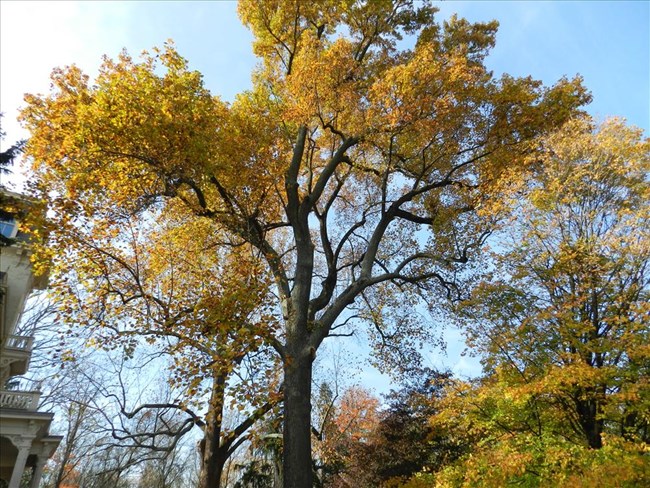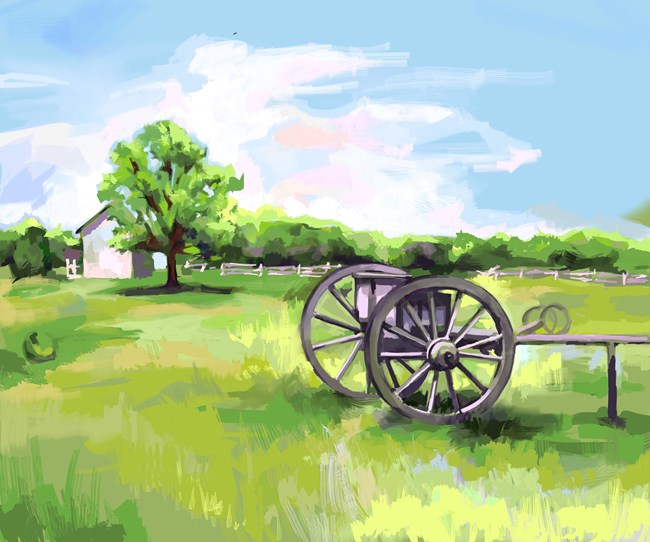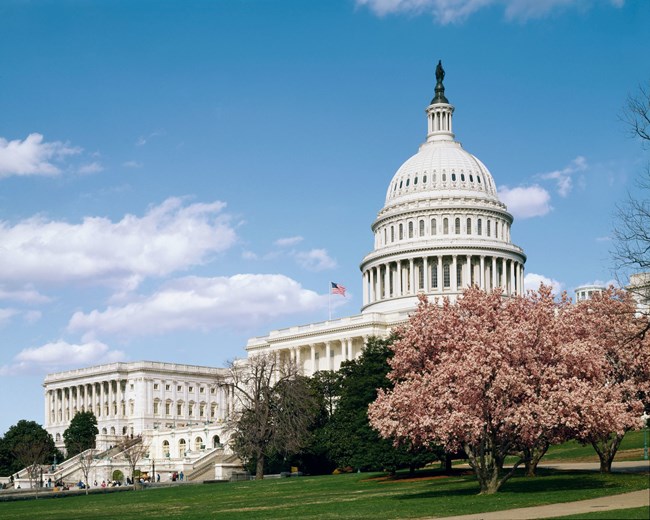Last updated: December 22, 2021
Article
Plants and Climate Change

NPS Photo / Graphic by 4C
Plants play an essential role in the functioning of life on Earth. These are just some of the benefits that people gain from natural systems, also known as ecosystem services:
- Oxygen: Through photosynthesis, plants use carbon dioxide, sunlight, and water to create energy and release oxygen.
- Recovery from natural disasters: Plants help protect soil from erosion and release nutrients to keep soils fertile. The growth and survival of plants depends on an ecosystem’s characteristics including the amount of sunlight, soil moisture, soil pH, flood depth, and salt tolerance.
- Food: Plants make up the foundation of the food chain. In addition to feeding wildlife, thousands of species of plants have been cultivated for human consumption as well.
- Interception of pollutants: Plants can catch airborne pollutants and purify drinking water. Wetland plants, for instance, help remove heavy metals and excessive levels of nutrients through their root systems.
- Medicine: Many medicines are derived or modelled upon compounds provided by the natural world.

The diverse treescape in the National Capital Area provides a wealth of ecological and historical purposes. Valuing Trees in the National Capital Region is a story map which quantifies the combined ecological, cultural, and economic values provided by the urban forest in the nation’s capital.
Climate Stressors
Unfortunately, the changing climate increases stressors that weaken plant resilience, disrupting forest structure and ecosystem services. Rising temperatures lead to more frequent droughts, wildfires, and invasive pest outbreaks, leading to the loss of plant species. That has numerous detrimental effects including:
- Lowered Productivity: Longer droughts and increased number of heat waves will stress plants, causing them to be less productive. That causes a ripple of problems because plants are the primary producers of life on our planet, generating over 99.9% of the Earth’s living material. Plant productivity supports wildlife and serves as the basis of a multitude of food chains. The decline of plants means there will be less food, which can further lead to declines in animal populations.
- Spread of Invasive Plants: When environmental conditions change, native species can lose their natural advantages and invasive species have a greater opportunity to thrive and in extreme cases, take over landscapes. The invasive European weed, Purple Loosestrife, thrives in wetlands and chokes out native vegetation.
- Vulnerability to Pests: Native plants can lose resiliency due to climate-change induced stressors, making them more vulnerable to invasive insect pests. As the weather warms, more destructive pests will survive the milder winters, have more reproductive success, and their growing populations will cause more damage to the native tree and plant species. The infamous Emerald Ash Borer for example has destroyed the ash trees in the DC region and across the US.
- Saltwater Intrusion: As sea level rises, water from the surrounding areas will intrude into low-lying plant ecosystems. This means an increased risk of saltwater intrusion in fresh ground water or freshwater wells, which can be damaging to plants and disrupt wetland ecosystems.
- Altered Ecosystem Structure: As temperatures increase and soil moisture changes, plant and vegetative zones are shifting in response. Trees are forced to migrate to higher elevations to find cooler, more suitable climates for their survival. Plants experiencing a shift in their range will affect the ecosystem they are leaving and the system they are moving into.
| Climate Effects | Terrestrial Plants | Aquatic Plants |
|---|---|---|
| Temperature Rise | Plants have adapted over millennia to the conditions in which they grow. The abrupt differences due to changing climate forces plants to migrate or go extinct. Increasing temperatures have brought about earlier bloom times for plants, creating a potential for timing mismatch between pollinators and plants. Pathogens and pests are often also more active in warmer temperatures. The extended growing season increases the pest populations’ ability to threaten the viability their target species. |
Because water absorbs heat well, submerged vegetation is in a better position to weather climate changes. However, once air temperatures reach their tipping point and water temperatures change, plants' physiological processes, growth rates, and reproductive patterns will be highly affected. DC wetlands like those at Kenilworth Park & Aquatic Gardens will be at risk when temperatures reach that point. |
| Nutrient Imbalance | Nitrogen is one of the most important nutrients for plant growth. Each plant species has specific nitrogen requirements to thrive. But during flooding events, nitrogen is leached from the soil and plants’ nitrogen supply is interrupted. | Eutrophication is the excessive runoff of nutrients from the land. An overabundance of nitrogen in the water leads to an overabundance of algae. Excessive algae growth depletes oxygen from the water, so other species do not have enough oxygen. Suspended algae also blocks sunlight from penetrating lower levels in the water so species submerged below cannot photosynthesize. |
| Flooding | Increased flooding events can oversaturate the soil which leads to the death of plants not adapted to standing water. The lack of oxygen in the soils can kill plant roots along with important microbes, like mycorrhiza, and can increase the prevalence of anaerobic soil species. | Stormwater runoff and flooding can bring impurities into the water ecosystems. This leads to decreased water clarity. For aquatic plants, decreased sunlight interrupts their ability to make sugars through photosynthesis. |
Climate Impacts at Our National Parks

Historic Witness Trees
Visitors at Monocacy National Battlefield can meet three ancient trees that were alive during the battle, called Witness Trees. Park staff have identified 75 possible Witness Trees at Monocacy. Protecting them requires regular assessment of their health and management of pests and disease.Witness trees could become more vulnerable in the years to come, however. Pests like the Gypsy Moth, whose larvae can strip a tree of leaves in a matter of days, are expected to spread as temperatures continue to rise. With the changing climate, Monocacy park staff will have to work even harder to protect the park’s historic trees for the future.

NPS / 4C park illustration
Warm-Season Grasslands
Warm-season grasslands consist of tall, native grasses that have large root systems and typically grow best during the summer months. These grasslands provide many ecological, cultural, and economic values at Antietam, Manassas, and Monocacy National Battlefields, and Wolf Trap National Park for the Performing Arts. But, these values are being impacted by climate change!
Increased erosion stemming from climate change can negatively impact soil quality. This may reduce plant forage production in the over 3,500 acres of agricultural land in the National Capital Area. Climate change also promotes the spread of nonnative plants, which can alter the historic landscapes of over 150 sites and monuments, including grasslands, in the region.

NPS / Carol Highsmith
Cherry Trees at Tidal Basin
Tree species like the Cherry Trees are iconic to the Tidal Basin. Sea level rise and increased precipitation leads to more frequent flooding of the Tidal Basin. Extended saltwater intrusion in the soil can weaken and eventually kill the cherry trees that line their shores. Slowing the rate of sea level rise is critical to saving coastal areas around the world.
Adaptation and Mitigation
While it is clear that climate change has had harmful effects on plant populations, there is hope for the future. Plants themselves provide a vital buffer to extreme climate change. Wetland ecosystems have several characteristics that mitigate some of climate change’s impacts such as slowing water flow which allows pollutants to be deposited in the wetlands and reduces erosion. They also store flood waters, reducing flooding where people live and work.
Terrestrial plants have similarly developed ways to adapt to climate change. Species like the oak tree are more tolerant to climate related stressors; they keep their stomata open in order to absorb more carbon than other tree species, and by taking in more carbon they will grow larger and faster. By virtue of their size, they end up offering more ecosystem services.
These types of adaptation and mitigation strategies will help us as the climate changes. Humans can support plant survival by making sustainable lifestyle decisions, including planting native species, avoiding pesticides and chemicals, and encouraging ecosystem reforestation efforts. Not only are these actions simple to take up, they support our environment as a whole.

